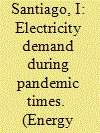| Srl | Item |
| 1 |
ID:
125770


|
|
|
|
|
| Publication |
2013.
|
| Summary/Abstract |
The growing energy consumption in the residential sector represents about 30% of global demand. This calls for Demand Side Management solutions propelling change in behaviors of end consumers, with the aim to reduce overall consumption as well as shift it to periods in which demand is lower and where the cost of generating energy is lower. Demand Side Management solutions require detailed knowledge about the patterns of energy consumption. The profile of electricity demand in the residential sector is highly correlated with the time of active occupancy of the dwellings; therefore in this study the occupancy patterns in Spanish properties was determined using the 2009-2010 Time Use Survey (TUS), conducted by the National Statistical Institute of Spain. The survey identifies three peaks in active occupancy, which coincide with morning, noon and evening. This information has been used to input into a stochastic model which generates active occupancy profiles of dwellings, with the aim to simulate domestic electricity consumption. TUS data were also used to identify which appliance-related activities could be considered for Demand Side Management solutions during the three peaks of occupancy.
|
|
|
|
|
|
|
|
|
|
|
|
|
|
|
|
| 2 |
ID:
175901


|
|
|
|
|
| Summary/Abstract |
Electricity demand and its typical load pattern are usually affected by many endogenous and exogenous factors to which the generation system must accordingly respond through utility operators. Lockdown measures to prevent the spread of COVID-19 imposed by many countries have led to sudden changes in socioeconomic habits which have had direct effects on the electricity systems. Therefore, a detailed analysis of how confinement measures have modified the electricity consumption in Spain, one of the countries most affected by this pandemic, has been performed in this work. Its electricity consumption has decreased by 13.49% from March 14 to April 30, compared to the average value of five previous years. Daily power demand profiles, especially morning and evening peaks, have been modified at homes, hospitals, and in the total power demand. These changes generate a greater uncertainty for the System Operator when making demand forecasts, but production deviations have increased by only 0.1%, thanks to the presence of a diversified generation mix, which has been modified during this period, increasing the proportion of renewable sources and decreasing CO2 emissions.
|
|
|
|
|
|
|
|
|
|
|
|
|
|
|
|